
The Cathedral Church of St Marie is the Roman Catholic cathedral in Sheffield, England. It lies in a slightly hidden location, just off Fargate shopping street, but signals its presence with a 195 feet (59 m) spire, the tallest in Sheffield. It is an especially fine example of an English Roman Catholic Cathedral, with much fine interior decoration. Re-ordering of the Sanctuary following the Second Vatican Council, has been sensitive. There are several particularly notable side altars, as well as historic statues and painted tiles.

The Church of Our Lady and Saint Nicholas is the Anglican parish church of Liverpool. The site is said to have been a place of worship since at least the 1250s. The church is situated close to the River Mersey near the Pier Head. The Chapel of St Nicholas was built on the site of St Mary del Quay, which in 1355 was determined to be too small for the growing borough of Liverpool. It is recorded in the National Heritage List for England as a designated Grade II listed building, and is an active parish church in the diocese of Liverpool, the archdeaconry of Liverpool and the deanery of Liverpool North. It is part of the Greater Churches Group. From 1813 to 1868 the Church was the tallest building in Liverpool at 174 feet [53 m], but then surpassed by the Welsh Presbyterian Church in Toxteth.

Manchester Cathedral, formally the Cathedral and Collegiate Church of St Mary, St Denys and St George, in Manchester, England, is the mother church of the Anglican Diocese of Manchester, seat of the Bishop of Manchester and the city's parish church. It is on Victoria Street in Manchester city centre and is a grade I listed building.
In Christianity, a collegiate church is a church where the daily office of worship is maintained by a college of canons, a non-monastic or "secular" community of clergy, organised as a self-governing corporate body, headed by a dignitary bearing a title which may vary, such as dean or provost. In its governance and religious observance a collegiate church is similar in some respects to a cathedral, although a collegiate church is not the seat of a bishop and has no diocesan responsibilities. Collegiate churches have often been supported by endowments, including lands, or by tithe income from appropriated benefices. The church building commonly provides both distinct spaces for congregational worship and for the choir offices of the canons.
A chantry is an ecclesiastical term that may have either of two related meanings:
- a chantry service, a Christian liturgy of prayers for the dead, which historically was an obiit, or
- a chantry chapel, a building on private land, or an area in a parish church or cathedral reserved for the performance of the "chantry duties".
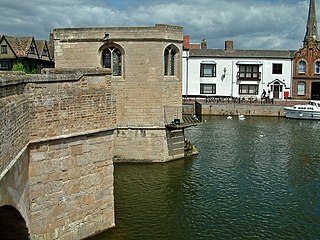
St Ives Bridge is a 15th-century bridge crossing the River Great Ouse in St Ives, Cambridgeshire, England. It is noted for being one of only four bridges in England to incorporate a chapel.
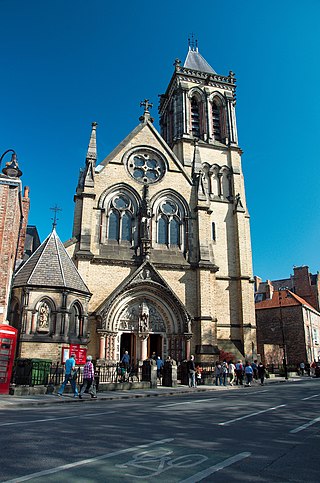
The Oratory Church of Saint Wilfrid, York is a Catholic church in York, England.

St Julian's Church, Norwich, is a Grade I listed parish church in the Church of England in Norwich, England. It is part of the Diocese of Norwich. During the Middle Ages, when the city was prosperous and possibly the second largest city in medieval England, the anchoress Julian of Norwich lived in a cell attached to the church. The cell was demolished during the 1530s.

St Peter's Church is the parish church of Prestbury, Cheshire, England. It is probably the fourth church on the site. The third, the Norman Chapel, stands in the churchyard. The church is recorded in the National Heritage List for England as a designated Grade I listed building. The Norman Chapel, the lychgate and west wall, the Hearse House, and the sundial in the churchyard are listed at Grade II. It is a Church of England parish church in the diocese of Chester, the archdeaconry of Macclesfield, and the deanery of Macclesfield.

The Chantry Chapel of St Mary the Virgin is a chantry chapel in Wakefield, West Yorkshire, England, and is designated a Grade I Listed building by English Heritage. It is located south of the city centre on the medieval Chantry Bridge over the River Calder. It is the only survivor of four chantries in Wakefield and the oldest and most ornate of the surviving bridge chapels in England. Others are at St Ives (Cambridgeshire), Rotherham, Derby and Bradford-on-Avon. The chapel has had three west fronts, the original medieval façade having been removed to Kettlethorpe Hall in 1832. The medieval bridge is a scheduled ancient monument.

St Mary's Church is a city centre church in Lichfield, Staffordshire England located on the south side of the market square. A church is reputed to have been on the present site since at least 1150 but the current building dates from 1870 and is a Grade II* listed building. The church was remodelled in the early 1980s and again in 1997-1999 and now serves a variety of purposes including Lichfield Library and Tourist Information on the ground floor, and on the top floor, The Hub at St Mary's is now home to a speciality coffee shop, art gallery, treasury exhibition and performing arts space.
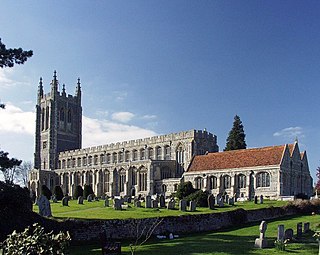
The Church of the Holy Trinity is a Grade I listed parish church of the Church of England in Long Melford, Suffolk, England. It is one of 310 medieval English churches dedicated to the Holy Trinity.
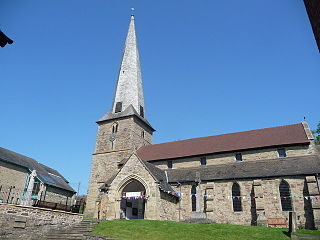
St Mary's Church is on Church Street, Cleobury Mortimer, Shropshire, England. It is an active Anglican parish church in the deanery of Ludlow, the archdeaconry of Ludlow, and the diocese of Hereford. Its benefice is united with those of six local parishes to form the Cleobury Benefice. The church is recorded in the National Heritage List for England as a designated Grade I listed building. It is notable for its shingled twisted spire.

St Peter and St Paul's Church, Lavenham is a Grade I listed parish church in the Church of England in Lavenham, Suffolk. It is a notable wool church and regarded as one of the finest examples of Late Perpendicular Gothic architecture in England.

The Church of St Peter and St Paul, Pickering is the parish church of the market town of Pickering in the county of North Yorkshire. The church sits on the top of a small hill in the centre of the town and its spire is visible across the Ryedale district. The church is part of the Church of England Diocese of York, and houses a collection of medieval wall paintings. It is a Grade I listed building.
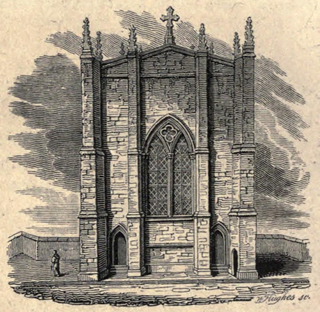
The Chapel of St Thomas on the Bridge was a bridge chapel built near the centre of "Old" London Bridge in the City of London and was completed by 1209. In 1548, during the Reformation, it was dissolved as a place of worship and soon afterwards converted to secular use. The building survived as a dwelling and warehouse until 1747 when the upper storey at street level was removed; the lower storey, which was built into the structure of one of the piers, remained in use as a store until Old London Bridge was demolished in 1832.

St Thomas of Canterbury Church is a Roman Catholic Parish church in Canterbury, Kent, England. It was built from 1874 to 1875 in the Gothic Revival style. It is situated on the corner of Burgate and Canterbury Lane, west of Lower Bridge Street, opposite the grounds of Canterbury Cathedral in the centre of the city. It is the only Roman Catholic church in Canterbury, built on the site of a medieval church ; the old St Mary Magdalen’s Tower was retained. The church contains relics of Thomas Becket.
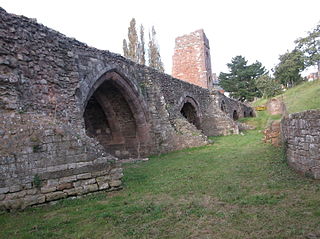
The Old Exe Bridge is a ruined medieval arch bridge in Exeter in south-western England. Construction of the bridge began in 1190, and was completed by 1214. The bridge is the oldest surviving bridge of its size in England and the oldest bridge in Britain with a chapel still on it. It replaced several rudimentary crossings which had been in use sporadically since Roman times. The project was the idea of Nicholas and Walter Gervase, father and son and influential local merchants, who travelled the country to raise funds. No known records survive of the bridge's builders. The result was a bridge at least 590 feet long, which probably had 17 or 18 arches, carrying the road diagonally from the west gate of the city wall across the River Exe and its wide, marshy flood plain.

St Mary's Bridge Chapel is a Church of England chapel in Derby, England. It is a bridge chapel, one of only a small number of medieval age that survive in England. It is a Grade I listed building.


















